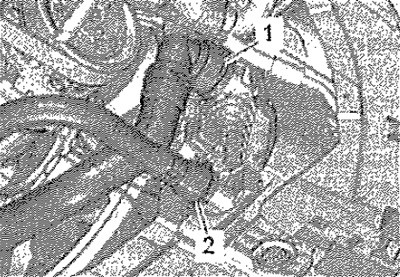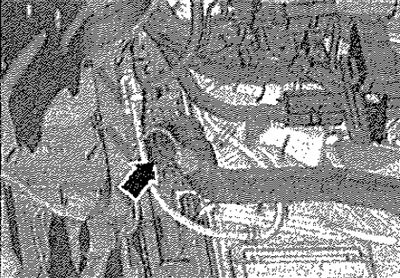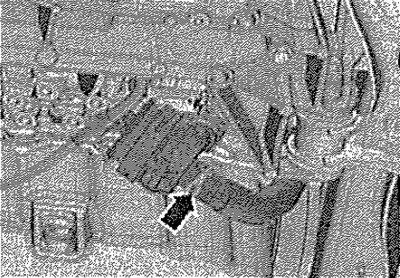Vehicles with radiator version 1
Raise retaining clip -arrow-, disconnect lower left coolant hose from radiator and drain off coolant.

Raise retaining clip -arrow-, disconnect lower right coolant hose from radiator and drain off coolant.

Vehicles with radiator version 2
Raise retaining clip -1-, disconnect lower right coolant hose from radiator and drain coolant. Raise retaining clip -2-, disconnect lower right coolant hose from radiator and drain coolant.

Vehicles with radiator version 3
Raise retaining clip -arrow-, disconnect lower left coolant hose from radiator and drain off coolant.

Raise retaining clip -1, 2-, detach coolant hoses from charge air cooler and drain off coolant.

All
Loosen clamp -arrow-, detach lower coolant hose from heater circulation pump -V488- and drain off coolant.

Refueling
Vehicles with radiator version 1
Connect coolant hose with quick-release coupling -arrow- at bottom left to radiator. Connect coolant hose with quick-release coupling -arrow- at bottom right to charge air cooler.
Vehicles with radiator version 2
Connect coolant hose with quick-release coupling -1- on bottom right to radiator. Connect coolant hose with quick coupling -2- on bottom right to charge air cooler.
Vehicles with radiator version 3
Connect coolant hose with quick-release coupling -arrow- at bottom left to radiator. Connect coolant hoses with quick-release coupling -1,2- on bottom right to charge air cooler.
All
Connect coolant hose with clamp -arrow- at bottom to heater circulation pump -V488-. Fill the coolant reservoir -VAS 6096- with at least 8 liters of a prepared solution of the appropriate concentration. Install adapter for coolant system tester -VAG 1274/8- on expansion tank. Fit coolant system charge unit -VAS 6096- to adapter -VAG 1274/8-. Lower the ventilation hose -1- into a suitable small container -2-.
Note: The air expelled from the system takes a small amount of coolant with it, a container is required to trap it.
Close valves -A- and -B- To do this, turn the levers perpendicular to the direction of fluid flow. Connect hose -3- to compressed air supply. Pressure: 0.6...1.0 MPa (6...10 bar).

Open the valve -B-, to do this turn the lever in the direction of the fluid flow. In the cooling system, under the action of the ejection pump, a vacuum is formed, the arrow of the device should move to the green area. In addition, briefly open tap -A- by turning its lever in the direction of fluid flow until coolant fills reservoir hose -VAS 6096-. Close the valve -A- again, Leave the valve -B- open for another 2 minutes In the cooling system, under the action of the ejection pump, a vacuum is formed again, the pointer of the device should again move to the green area. Close valve -B-. The instrument pointer must remain in the green area. In this case, the vacuum in the cooling system will be sufficient for the subsequent filling of the cooling system.
Note: If the arrow does not reach the green area, repeat the process. If the vacuum drops, check the cooling system for leaks.

Disconnect the compressed air hose. Open tap -A-. The vacuum draws the coolant from the reservoir -VAS 6096- into the cooling system and thus fills the system. Remove coolant filling tool -VAS 6096- from expansion tank. Top up the coolant up to the "max" mark" on the tank.
Note: The fittings as well as the air ducts and hoses must be degreased before installation.
Install soundproofing. On vehicles with an auxiliary heater, turn it on for about 30 seconds. Set the temperature to "HI". Switch off the air conditioner compressor by pressing the AC button. The LED in the key should not light up. Filling and draining the coolant circuit - Tester, Guided functions, Filling the coolant circuit. Let the engine run to warm it up until the thermostat opens or the radiator fan runs once. Let the engine cool down. Check coolant level. Top up the coolant approx. 5 mm above the "max" mark".
Note: During driving, any residual air will be expelled through permanently operating vent lines. Check coolant level. When the engine is cold, the coolant level must be between the marks "min" and "max". When the engine is warm, the coolant level may be at "max"" or above it. Top up coolant if necessary.
